Intervention for Absenteeism in High-School Students
VerifiedAdded on 2022/10/16
|18
|3623
|373
AI Summary
This report focuses on the early truancy prevention program as a method of eliminating truancy in high-schools. The report identifies the problem of absenteeism, its prevalence, and the need for intervention. It also discusses the factors addressed by the intervention, the implementation, and the evaluation of the effectiveness of the intervention.
Contribute Materials
Your contribution can guide someone’s learning journey. Share your
documents today.
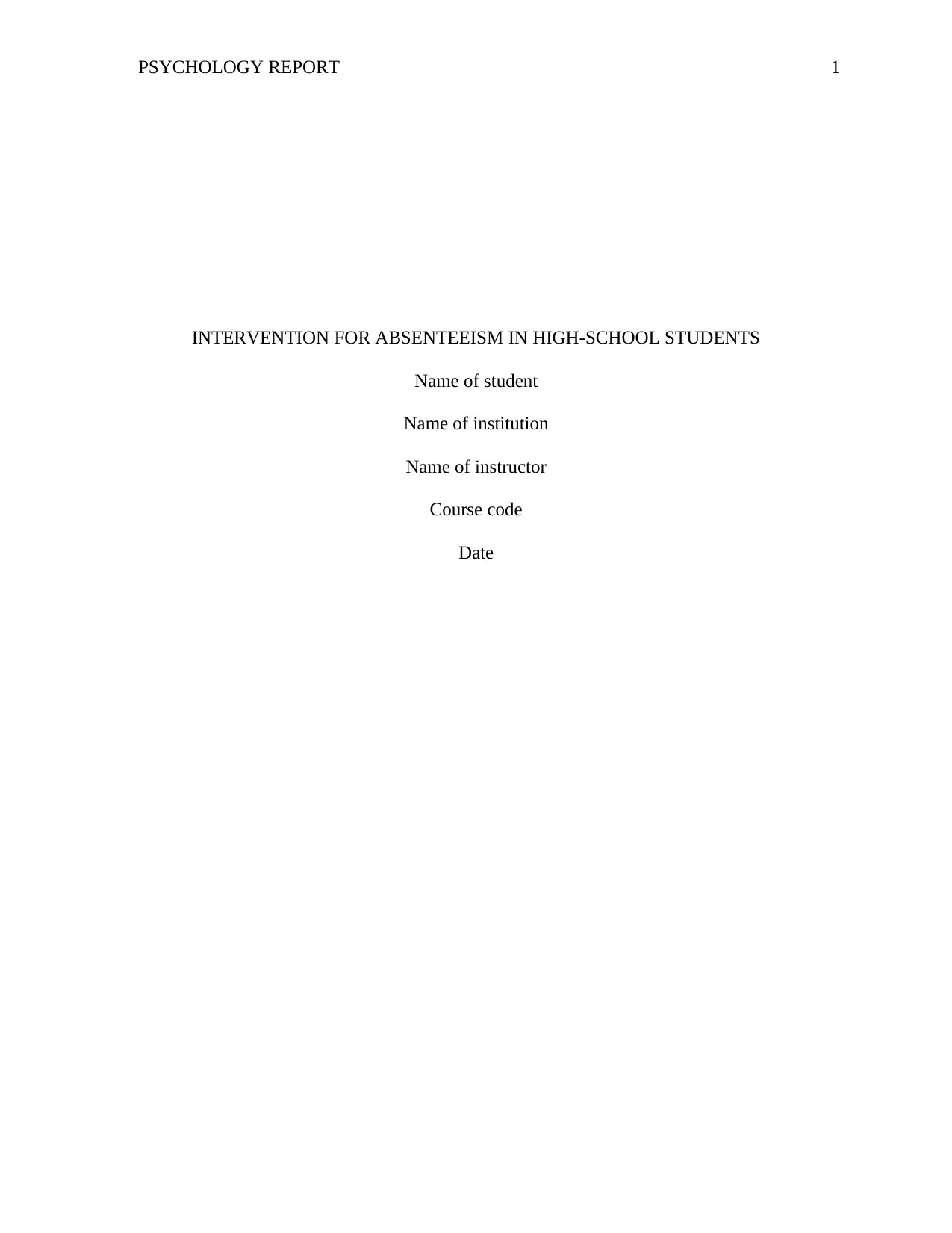
PSYCHOLOGY REPORT 1
INTERVENTION FOR ABSENTEEISM IN HIGH-SCHOOL STUDENTS
Name of student
Name of institution
Name of instructor
Course code
Date
INTERVENTION FOR ABSENTEEISM IN HIGH-SCHOOL STUDENTS
Name of student
Name of institution
Name of instructor
Course code
Date
Secure Best Marks with AI Grader
Need help grading? Try our AI Grader for instant feedback on your assignments.
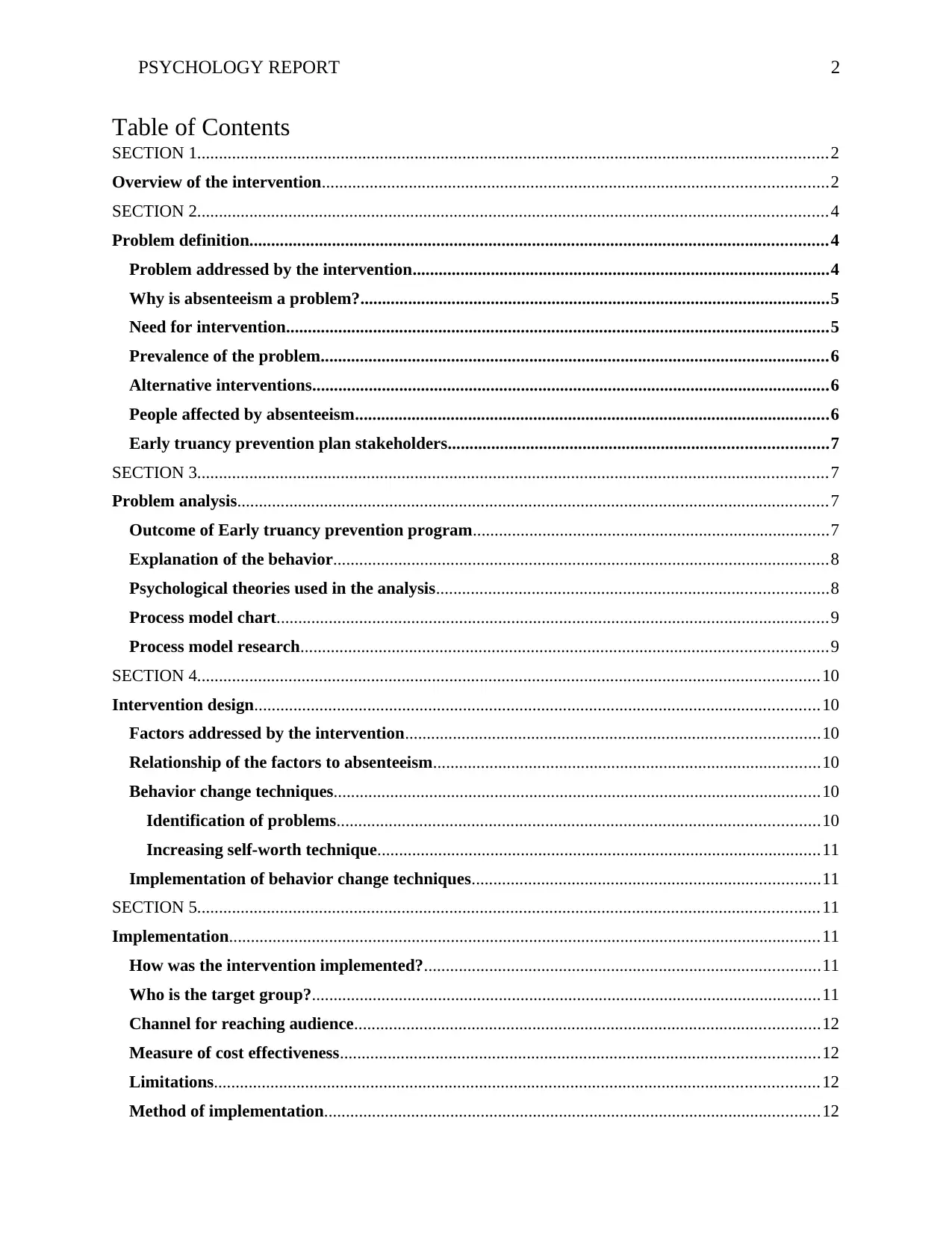
PSYCHOLOGY REPORT 2
Table of Contents
SECTION 1.................................................................................................................................................2
Overview of the intervention....................................................................................................................2
SECTION 2.................................................................................................................................................4
Problem definition.....................................................................................................................................4
Problem addressed by the intervention................................................................................................4
Why is absenteeism a problem?............................................................................................................5
Need for intervention.............................................................................................................................5
Prevalence of the problem.....................................................................................................................6
Alternative interventions.......................................................................................................................6
People affected by absenteeism.............................................................................................................6
Early truancy prevention plan stakeholders.......................................................................................7
SECTION 3.................................................................................................................................................7
Problem analysis........................................................................................................................................7
Outcome of Early truancy prevention program..................................................................................7
Explanation of the behavior..................................................................................................................8
Psychological theories used in the analysis..........................................................................................8
Process model chart...............................................................................................................................9
Process model research.........................................................................................................................9
SECTION 4...............................................................................................................................................10
Intervention design..................................................................................................................................10
Factors addressed by the intervention...............................................................................................10
Relationship of the factors to absenteeism.........................................................................................10
Behavior change techniques................................................................................................................10
Identification of problems...............................................................................................................10
Increasing self-worth technique......................................................................................................11
Implementation of behavior change techniques................................................................................11
SECTION 5...............................................................................................................................................11
Implementation........................................................................................................................................11
How was the intervention implemented?...........................................................................................11
Who is the target group?.....................................................................................................................11
Channel for reaching audience...........................................................................................................12
Measure of cost effectiveness..............................................................................................................12
Limitations...........................................................................................................................................12
Method of implementation..................................................................................................................12
Table of Contents
SECTION 1.................................................................................................................................................2
Overview of the intervention....................................................................................................................2
SECTION 2.................................................................................................................................................4
Problem definition.....................................................................................................................................4
Problem addressed by the intervention................................................................................................4
Why is absenteeism a problem?............................................................................................................5
Need for intervention.............................................................................................................................5
Prevalence of the problem.....................................................................................................................6
Alternative interventions.......................................................................................................................6
People affected by absenteeism.............................................................................................................6
Early truancy prevention plan stakeholders.......................................................................................7
SECTION 3.................................................................................................................................................7
Problem analysis........................................................................................................................................7
Outcome of Early truancy prevention program..................................................................................7
Explanation of the behavior..................................................................................................................8
Psychological theories used in the analysis..........................................................................................8
Process model chart...............................................................................................................................9
Process model research.........................................................................................................................9
SECTION 4...............................................................................................................................................10
Intervention design..................................................................................................................................10
Factors addressed by the intervention...............................................................................................10
Relationship of the factors to absenteeism.........................................................................................10
Behavior change techniques................................................................................................................10
Identification of problems...............................................................................................................10
Increasing self-worth technique......................................................................................................11
Implementation of behavior change techniques................................................................................11
SECTION 5...............................................................................................................................................11
Implementation........................................................................................................................................11
How was the intervention implemented?...........................................................................................11
Who is the target group?.....................................................................................................................11
Channel for reaching audience...........................................................................................................12
Measure of cost effectiveness..............................................................................................................12
Limitations...........................................................................................................................................12
Method of implementation..................................................................................................................12
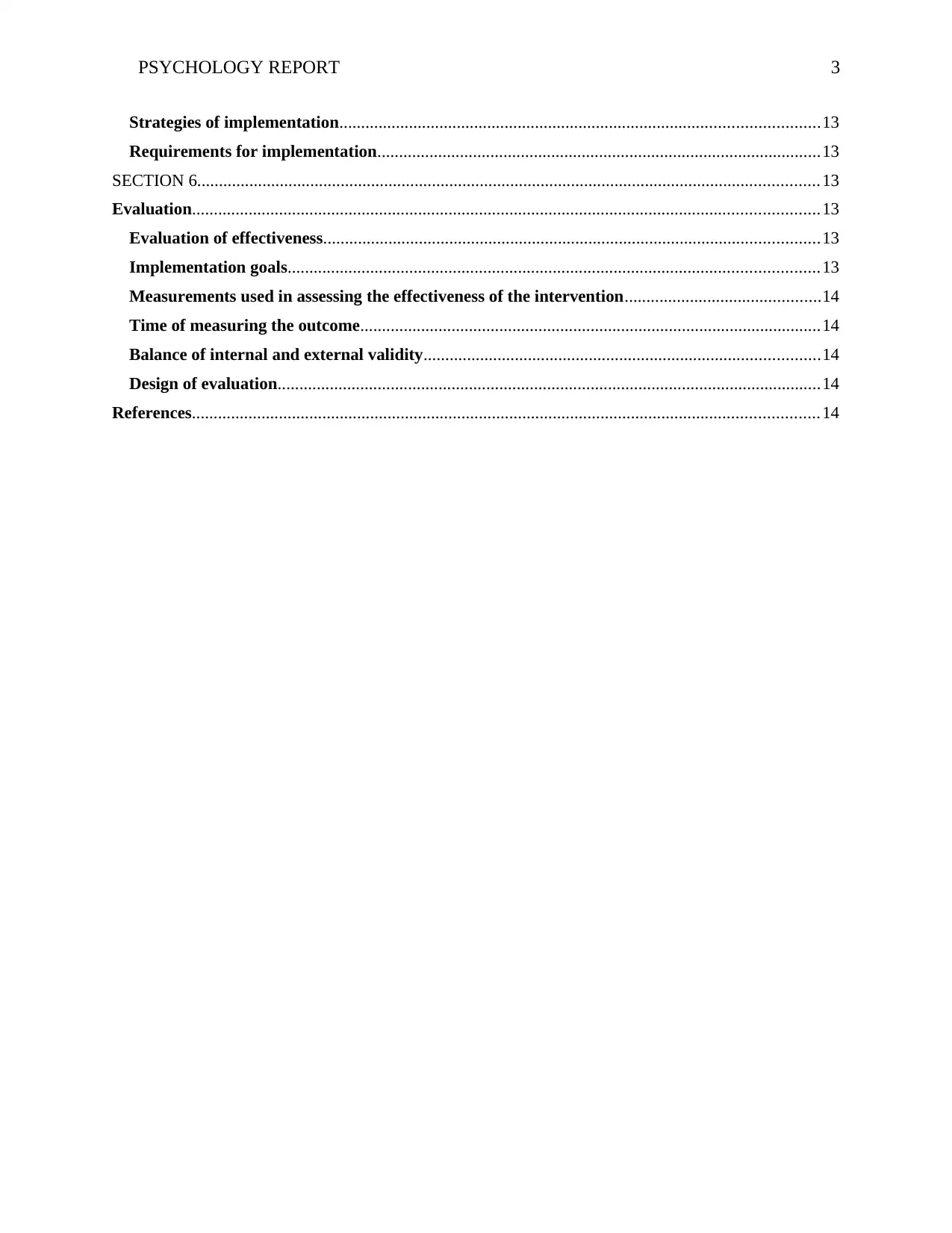
PSYCHOLOGY REPORT 3
Strategies of implementation..............................................................................................................13
Requirements for implementation......................................................................................................13
SECTION 6...............................................................................................................................................13
Evaluation................................................................................................................................................13
Evaluation of effectiveness..................................................................................................................13
Implementation goals..........................................................................................................................13
Measurements used in assessing the effectiveness of the intervention.............................................14
Time of measuring the outcome..........................................................................................................14
Balance of internal and external validity...........................................................................................14
Design of evaluation.............................................................................................................................14
References................................................................................................................................................14
Strategies of implementation..............................................................................................................13
Requirements for implementation......................................................................................................13
SECTION 6...............................................................................................................................................13
Evaluation................................................................................................................................................13
Evaluation of effectiveness..................................................................................................................13
Implementation goals..........................................................................................................................13
Measurements used in assessing the effectiveness of the intervention.............................................14
Time of measuring the outcome..........................................................................................................14
Balance of internal and external validity...........................................................................................14
Design of evaluation.............................................................................................................................14
References................................................................................................................................................14
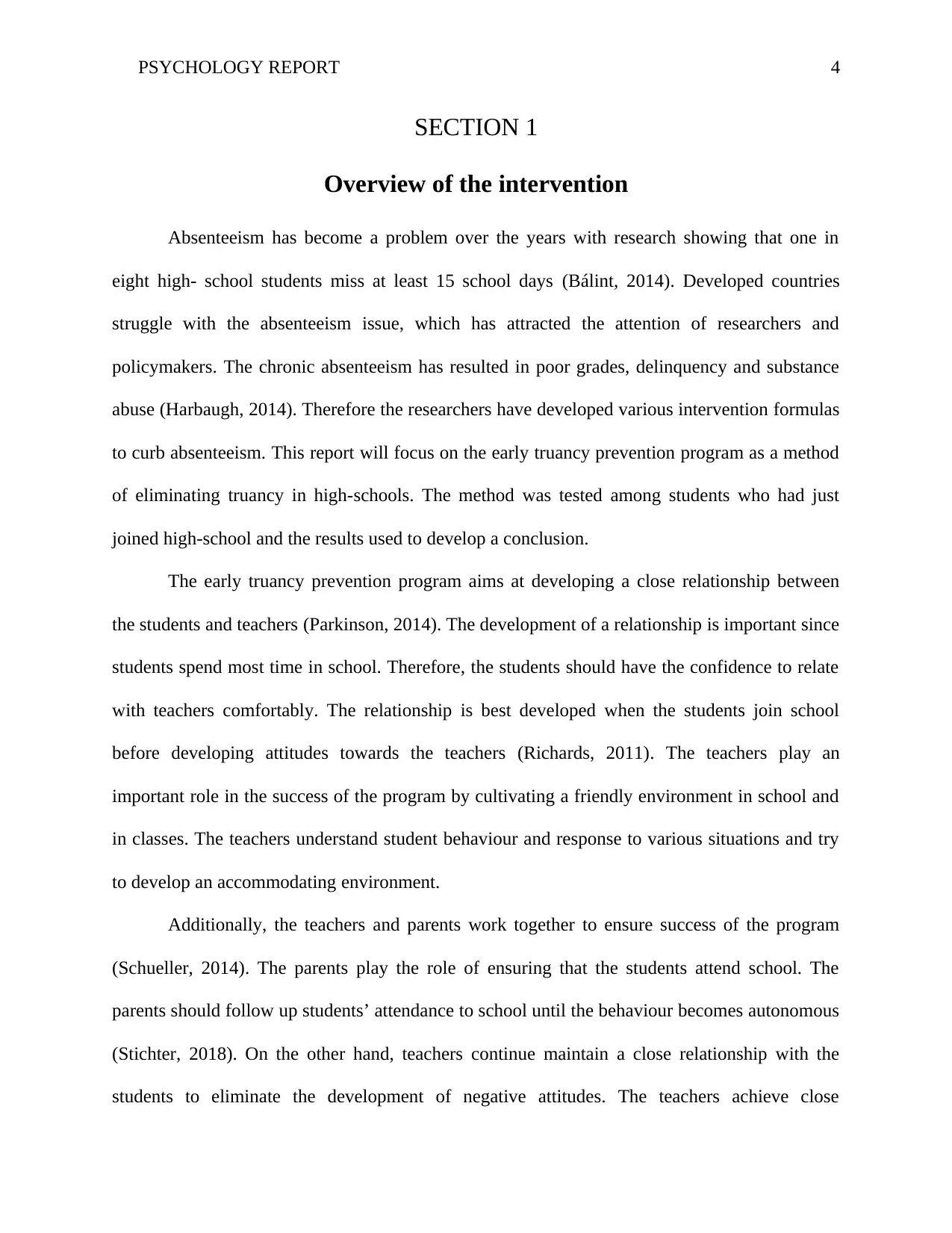
PSYCHOLOGY REPORT 4
SECTION 1
Overview of the intervention
Absenteeism has become a problem over the years with research showing that one in
eight high- school students miss at least 15 school days (Bálint, 2014). Developed countries
struggle with the absenteeism issue, which has attracted the attention of researchers and
policymakers. The chronic absenteeism has resulted in poor grades, delinquency and substance
abuse (Harbaugh, 2014). Therefore the researchers have developed various intervention formulas
to curb absenteeism. This report will focus on the early truancy prevention program as a method
of eliminating truancy in high-schools. The method was tested among students who had just
joined high-school and the results used to develop a conclusion.
The early truancy prevention program aims at developing a close relationship between
the students and teachers (Parkinson, 2014). The development of a relationship is important since
students spend most time in school. Therefore, the students should have the confidence to relate
with teachers comfortably. The relationship is best developed when the students join school
before developing attitudes towards the teachers (Richards, 2011). The teachers play an
important role in the success of the program by cultivating a friendly environment in school and
in classes. The teachers understand student behaviour and response to various situations and try
to develop an accommodating environment.
Additionally, the teachers and parents work together to ensure success of the program
(Schueller, 2014). The parents play the role of ensuring that the students attend school. The
parents should follow up students’ attendance to school until the behaviour becomes autonomous
(Stichter, 2018). On the other hand, teachers continue maintain a close relationship with the
students to eliminate the development of negative attitudes. The teachers achieve close
SECTION 1
Overview of the intervention
Absenteeism has become a problem over the years with research showing that one in
eight high- school students miss at least 15 school days (Bálint, 2014). Developed countries
struggle with the absenteeism issue, which has attracted the attention of researchers and
policymakers. The chronic absenteeism has resulted in poor grades, delinquency and substance
abuse (Harbaugh, 2014). Therefore the researchers have developed various intervention formulas
to curb absenteeism. This report will focus on the early truancy prevention program as a method
of eliminating truancy in high-schools. The method was tested among students who had just
joined high-school and the results used to develop a conclusion.
The early truancy prevention program aims at developing a close relationship between
the students and teachers (Parkinson, 2014). The development of a relationship is important since
students spend most time in school. Therefore, the students should have the confidence to relate
with teachers comfortably. The relationship is best developed when the students join school
before developing attitudes towards the teachers (Richards, 2011). The teachers play an
important role in the success of the program by cultivating a friendly environment in school and
in classes. The teachers understand student behaviour and response to various situations and try
to develop an accommodating environment.
Additionally, the teachers and parents work together to ensure success of the program
(Schueller, 2014). The parents play the role of ensuring that the students attend school. The
parents should follow up students’ attendance to school until the behaviour becomes autonomous
(Stichter, 2018). On the other hand, teachers continue maintain a close relationship with the
students to eliminate the development of negative attitudes. The teachers achieve close
Secure Best Marks with AI Grader
Need help grading? Try our AI Grader for instant feedback on your assignments.
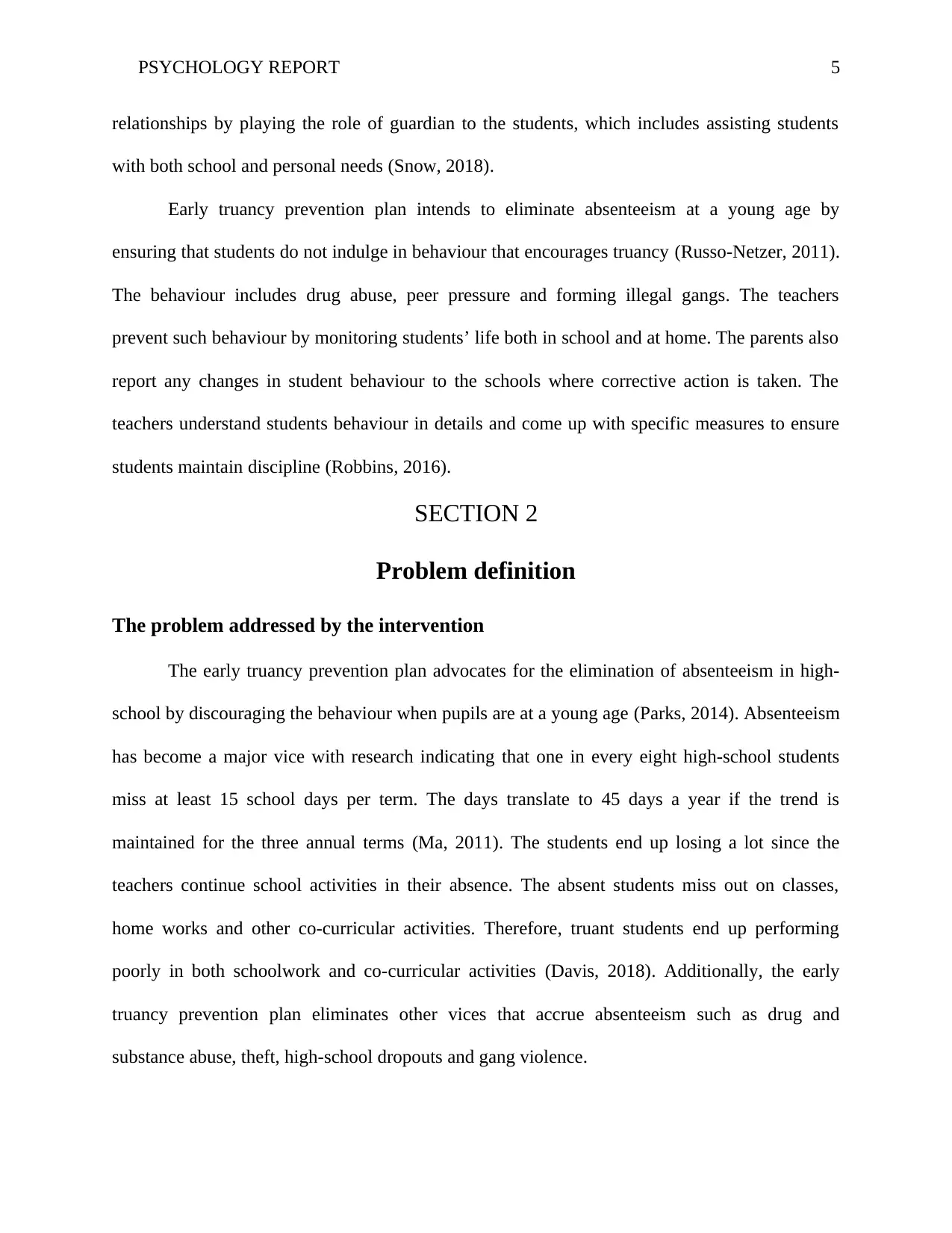
PSYCHOLOGY REPORT 5
relationships by playing the role of guardian to the students, which includes assisting students
with both school and personal needs (Snow, 2018).
Early truancy prevention plan intends to eliminate absenteeism at a young age by
ensuring that students do not indulge in behaviour that encourages truancy (Russo-Netzer, 2011).
The behaviour includes drug abuse, peer pressure and forming illegal gangs. The teachers
prevent such behaviour by monitoring students’ life both in school and at home. The parents also
report any changes in student behaviour to the schools where corrective action is taken. The
teachers understand students behaviour in details and come up with specific measures to ensure
students maintain discipline (Robbins, 2016).
SECTION 2
Problem definition
The problem addressed by the intervention
The early truancy prevention plan advocates for the elimination of absenteeism in high-
school by discouraging the behaviour when pupils are at a young age (Parks, 2014). Absenteeism
has become a major vice with research indicating that one in every eight high-school students
miss at least 15 school days per term. The days translate to 45 days a year if the trend is
maintained for the three annual terms (Ma, 2011). The students end up losing a lot since the
teachers continue school activities in their absence. The absent students miss out on classes,
home works and other co-curricular activities. Therefore, truant students end up performing
poorly in both schoolwork and co-curricular activities (Davis, 2018). Additionally, the early
truancy prevention plan eliminates other vices that accrue absenteeism such as drug and
substance abuse, theft, high-school dropouts and gang violence.
relationships by playing the role of guardian to the students, which includes assisting students
with both school and personal needs (Snow, 2018).
Early truancy prevention plan intends to eliminate absenteeism at a young age by
ensuring that students do not indulge in behaviour that encourages truancy (Russo-Netzer, 2011).
The behaviour includes drug abuse, peer pressure and forming illegal gangs. The teachers
prevent such behaviour by monitoring students’ life both in school and at home. The parents also
report any changes in student behaviour to the schools where corrective action is taken. The
teachers understand students behaviour in details and come up with specific measures to ensure
students maintain discipline (Robbins, 2016).
SECTION 2
Problem definition
The problem addressed by the intervention
The early truancy prevention plan advocates for the elimination of absenteeism in high-
school by discouraging the behaviour when pupils are at a young age (Parks, 2014). Absenteeism
has become a major vice with research indicating that one in every eight high-school students
miss at least 15 school days per term. The days translate to 45 days a year if the trend is
maintained for the three annual terms (Ma, 2011). The students end up losing a lot since the
teachers continue school activities in their absence. The absent students miss out on classes,
home works and other co-curricular activities. Therefore, truant students end up performing
poorly in both schoolwork and co-curricular activities (Davis, 2018). Additionally, the early
truancy prevention plan eliminates other vices that accrue absenteeism such as drug and
substance abuse, theft, high-school dropouts and gang violence.
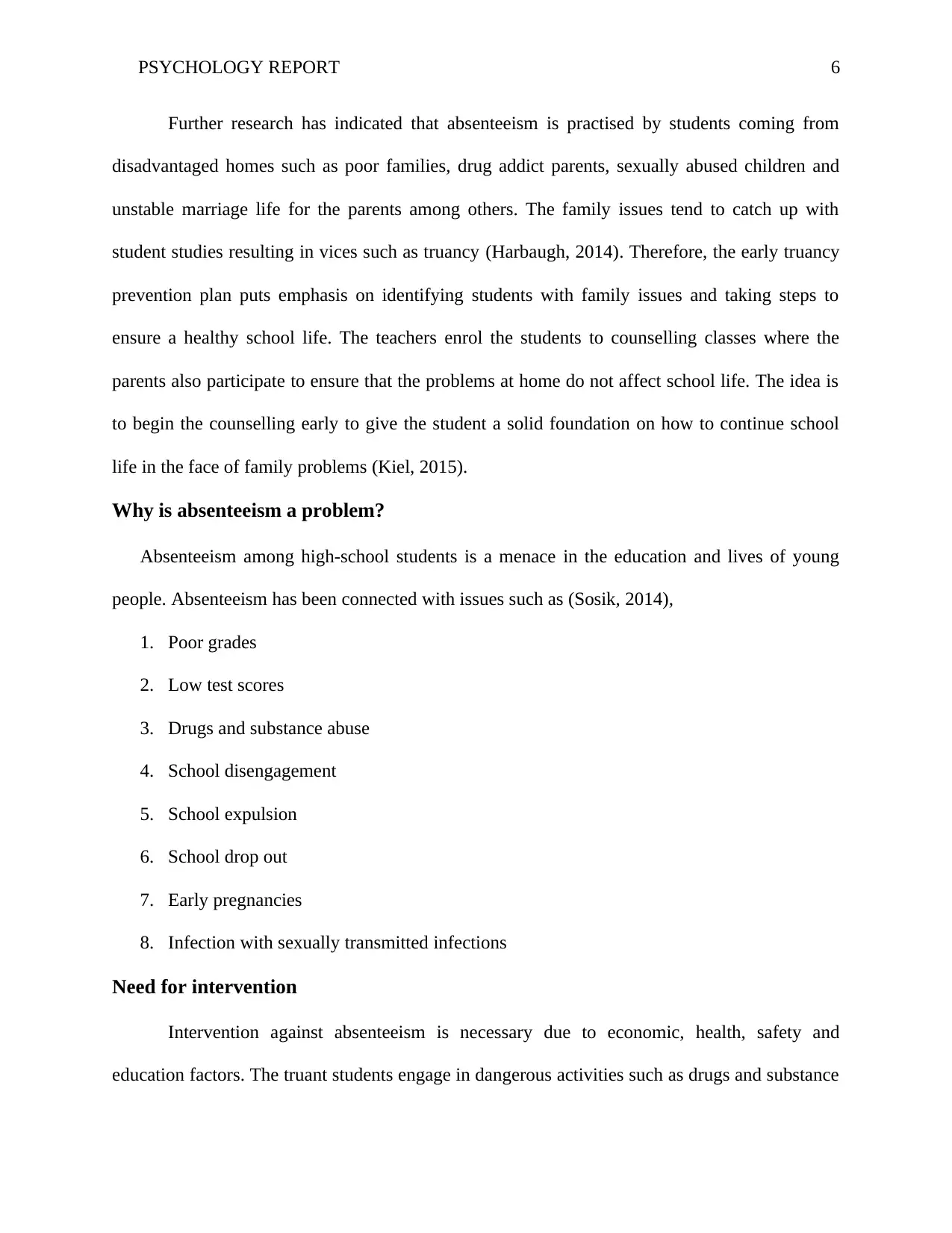
PSYCHOLOGY REPORT 6
Further research has indicated that absenteeism is practised by students coming from
disadvantaged homes such as poor families, drug addict parents, sexually abused children and
unstable marriage life for the parents among others. The family issues tend to catch up with
student studies resulting in vices such as truancy (Harbaugh, 2014). Therefore, the early truancy
prevention plan puts emphasis on identifying students with family issues and taking steps to
ensure a healthy school life. The teachers enrol the students to counselling classes where the
parents also participate to ensure that the problems at home do not affect school life. The idea is
to begin the counselling early to give the student a solid foundation on how to continue school
life in the face of family problems (Kiel, 2015).
Why is absenteeism a problem?
Absenteeism among high-school students is a menace in the education and lives of young
people. Absenteeism has been connected with issues such as (Sosik, 2014),
1. Poor grades
2. Low test scores
3. Drugs and substance abuse
4. School disengagement
5. School expulsion
6. School drop out
7. Early pregnancies
8. Infection with sexually transmitted infections
Need for intervention
Intervention against absenteeism is necessary due to economic, health, safety and
education factors. The truant students engage in dangerous activities such as drugs and substance
Further research has indicated that absenteeism is practised by students coming from
disadvantaged homes such as poor families, drug addict parents, sexually abused children and
unstable marriage life for the parents among others. The family issues tend to catch up with
student studies resulting in vices such as truancy (Harbaugh, 2014). Therefore, the early truancy
prevention plan puts emphasis on identifying students with family issues and taking steps to
ensure a healthy school life. The teachers enrol the students to counselling classes where the
parents also participate to ensure that the problems at home do not affect school life. The idea is
to begin the counselling early to give the student a solid foundation on how to continue school
life in the face of family problems (Kiel, 2015).
Why is absenteeism a problem?
Absenteeism among high-school students is a menace in the education and lives of young
people. Absenteeism has been connected with issues such as (Sosik, 2014),
1. Poor grades
2. Low test scores
3. Drugs and substance abuse
4. School disengagement
5. School expulsion
6. School drop out
7. Early pregnancies
8. Infection with sexually transmitted infections
Need for intervention
Intervention against absenteeism is necessary due to economic, health, safety and
education factors. The truant students engage in dangerous activities such as drugs and substance
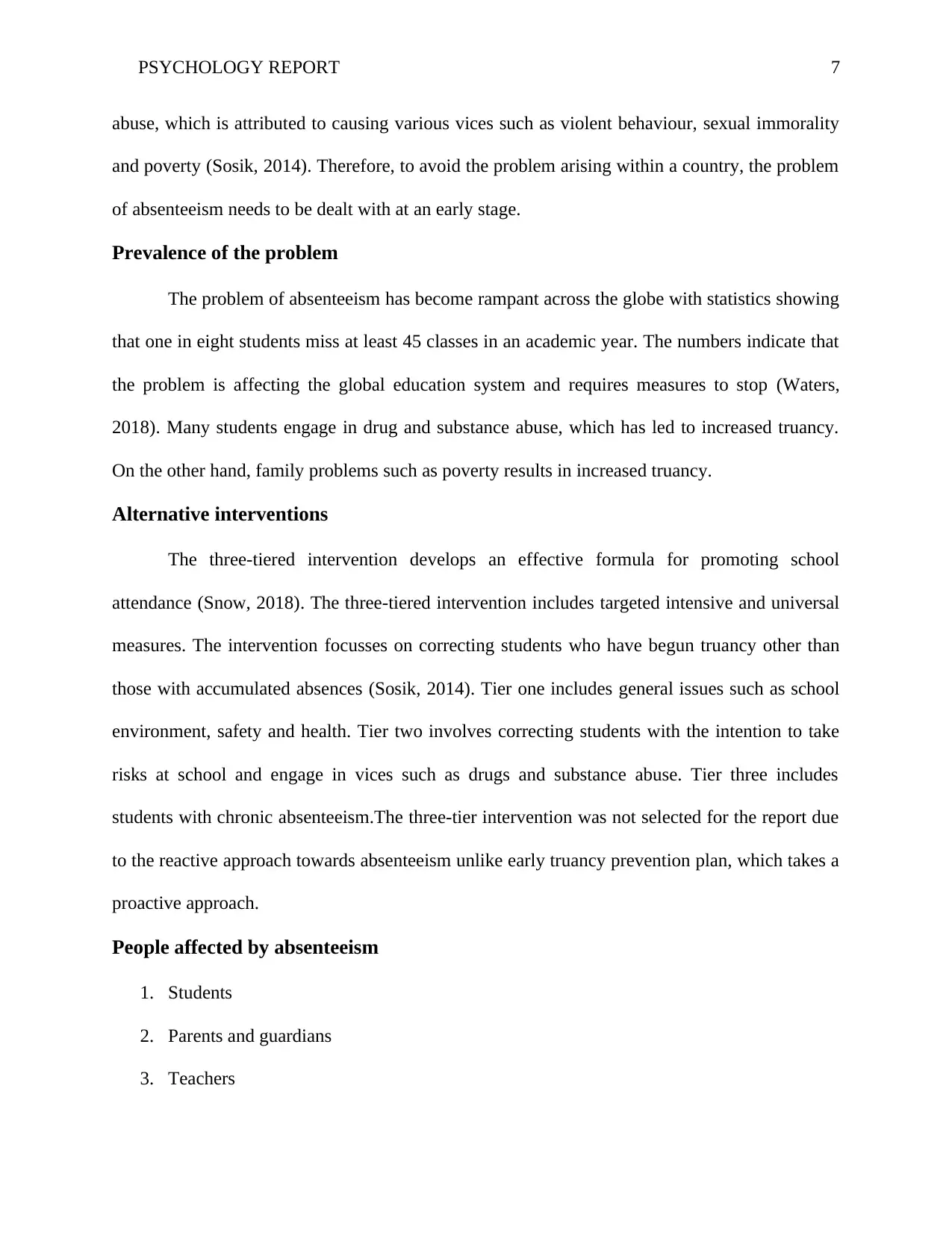
PSYCHOLOGY REPORT 7
abuse, which is attributed to causing various vices such as violent behaviour, sexual immorality
and poverty (Sosik, 2014). Therefore, to avoid the problem arising within a country, the problem
of absenteeism needs to be dealt with at an early stage.
Prevalence of the problem
The problem of absenteeism has become rampant across the globe with statistics showing
that one in eight students miss at least 45 classes in an academic year. The numbers indicate that
the problem is affecting the global education system and requires measures to stop (Waters,
2018). Many students engage in drug and substance abuse, which has led to increased truancy.
On the other hand, family problems such as poverty results in increased truancy.
Alternative interventions
The three-tiered intervention develops an effective formula for promoting school
attendance (Snow, 2018). The three-tiered intervention includes targeted intensive and universal
measures. The intervention focusses on correcting students who have begun truancy other than
those with accumulated absences (Sosik, 2014). Tier one includes general issues such as school
environment, safety and health. Tier two involves correcting students with the intention to take
risks at school and engage in vices such as drugs and substance abuse. Tier three includes
students with chronic absenteeism.The three-tier intervention was not selected for the report due
to the reactive approach towards absenteeism unlike early truancy prevention plan, which takes a
proactive approach.
People affected by absenteeism
1. Students
2. Parents and guardians
3. Teachers
abuse, which is attributed to causing various vices such as violent behaviour, sexual immorality
and poverty (Sosik, 2014). Therefore, to avoid the problem arising within a country, the problem
of absenteeism needs to be dealt with at an early stage.
Prevalence of the problem
The problem of absenteeism has become rampant across the globe with statistics showing
that one in eight students miss at least 45 classes in an academic year. The numbers indicate that
the problem is affecting the global education system and requires measures to stop (Waters,
2018). Many students engage in drug and substance abuse, which has led to increased truancy.
On the other hand, family problems such as poverty results in increased truancy.
Alternative interventions
The three-tiered intervention develops an effective formula for promoting school
attendance (Snow, 2018). The three-tiered intervention includes targeted intensive and universal
measures. The intervention focusses on correcting students who have begun truancy other than
those with accumulated absences (Sosik, 2014). Tier one includes general issues such as school
environment, safety and health. Tier two involves correcting students with the intention to take
risks at school and engage in vices such as drugs and substance abuse. Tier three includes
students with chronic absenteeism.The three-tier intervention was not selected for the report due
to the reactive approach towards absenteeism unlike early truancy prevention plan, which takes a
proactive approach.
People affected by absenteeism
1. Students
2. Parents and guardians
3. Teachers
Paraphrase This Document
Need a fresh take? Get an instant paraphrase of this document with our AI Paraphraser
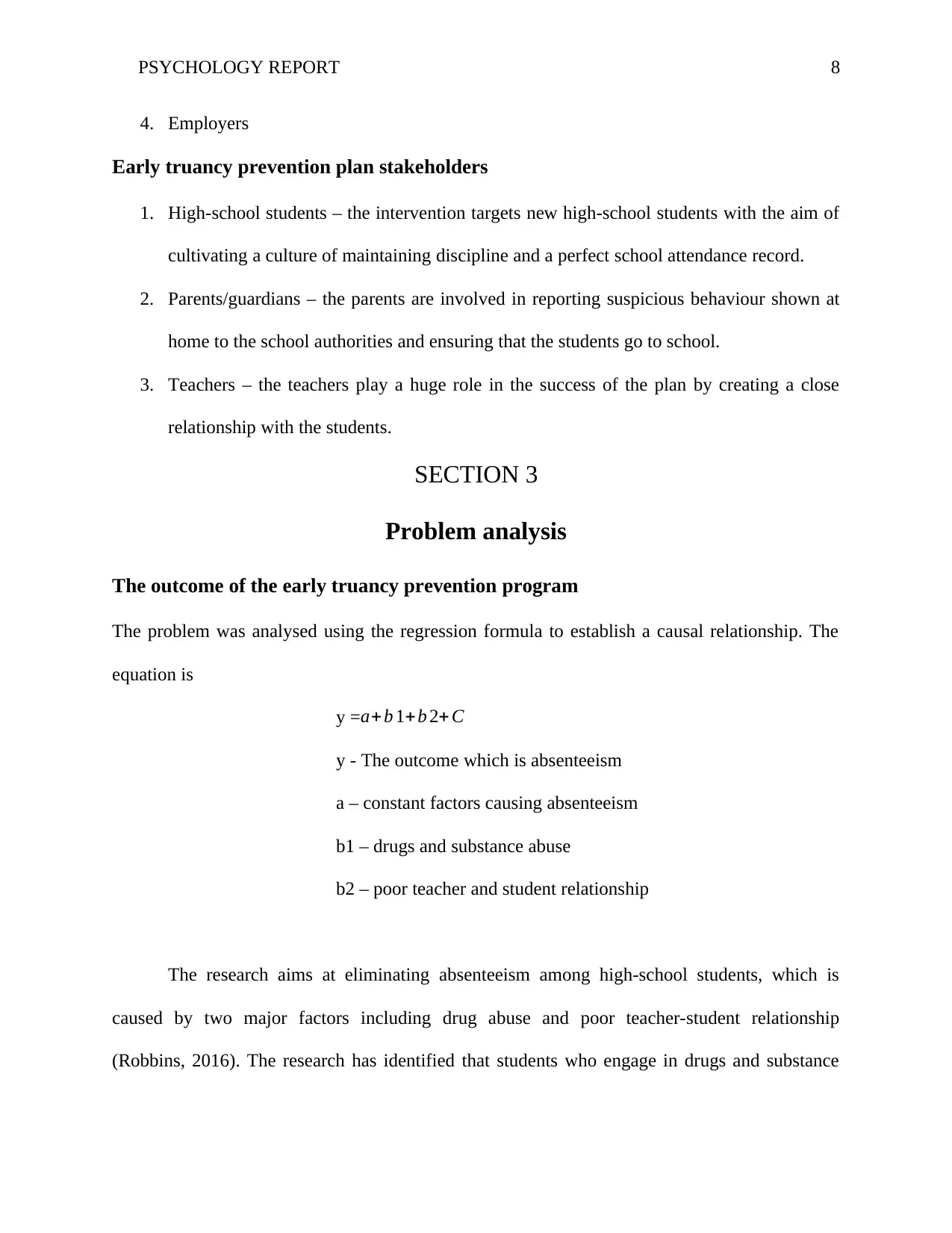
PSYCHOLOGY REPORT 8
4. Employers
Early truancy prevention plan stakeholders
1. High-school students – the intervention targets new high-school students with the aim of
cultivating a culture of maintaining discipline and a perfect school attendance record.
2. Parents/guardians – the parents are involved in reporting suspicious behaviour shown at
home to the school authorities and ensuring that the students go to school.
3. Teachers – the teachers play a huge role in the success of the plan by creating a close
relationship with the students.
SECTION 3
Problem analysis
The outcome of the early truancy prevention program
The problem was analysed using the regression formula to establish a causal relationship. The
equation is
y =a+ b 1+b 2+ C
y - The outcome which is absenteeism
a – constant factors causing absenteeism
b1 – drugs and substance abuse
b2 – poor teacher and student relationship
The research aims at eliminating absenteeism among high-school students, which is
caused by two major factors including drug abuse and poor teacher-student relationship
(Robbins, 2016). The research has identified that students who engage in drugs and substance
4. Employers
Early truancy prevention plan stakeholders
1. High-school students – the intervention targets new high-school students with the aim of
cultivating a culture of maintaining discipline and a perfect school attendance record.
2. Parents/guardians – the parents are involved in reporting suspicious behaviour shown at
home to the school authorities and ensuring that the students go to school.
3. Teachers – the teachers play a huge role in the success of the plan by creating a close
relationship with the students.
SECTION 3
Problem analysis
The outcome of the early truancy prevention program
The problem was analysed using the regression formula to establish a causal relationship. The
equation is
y =a+ b 1+b 2+ C
y - The outcome which is absenteeism
a – constant factors causing absenteeism
b1 – drugs and substance abuse
b2 – poor teacher and student relationship
The research aims at eliminating absenteeism among high-school students, which is
caused by two major factors including drug abuse and poor teacher-student relationship
(Robbins, 2016). The research has identified that students who engage in drugs and substance
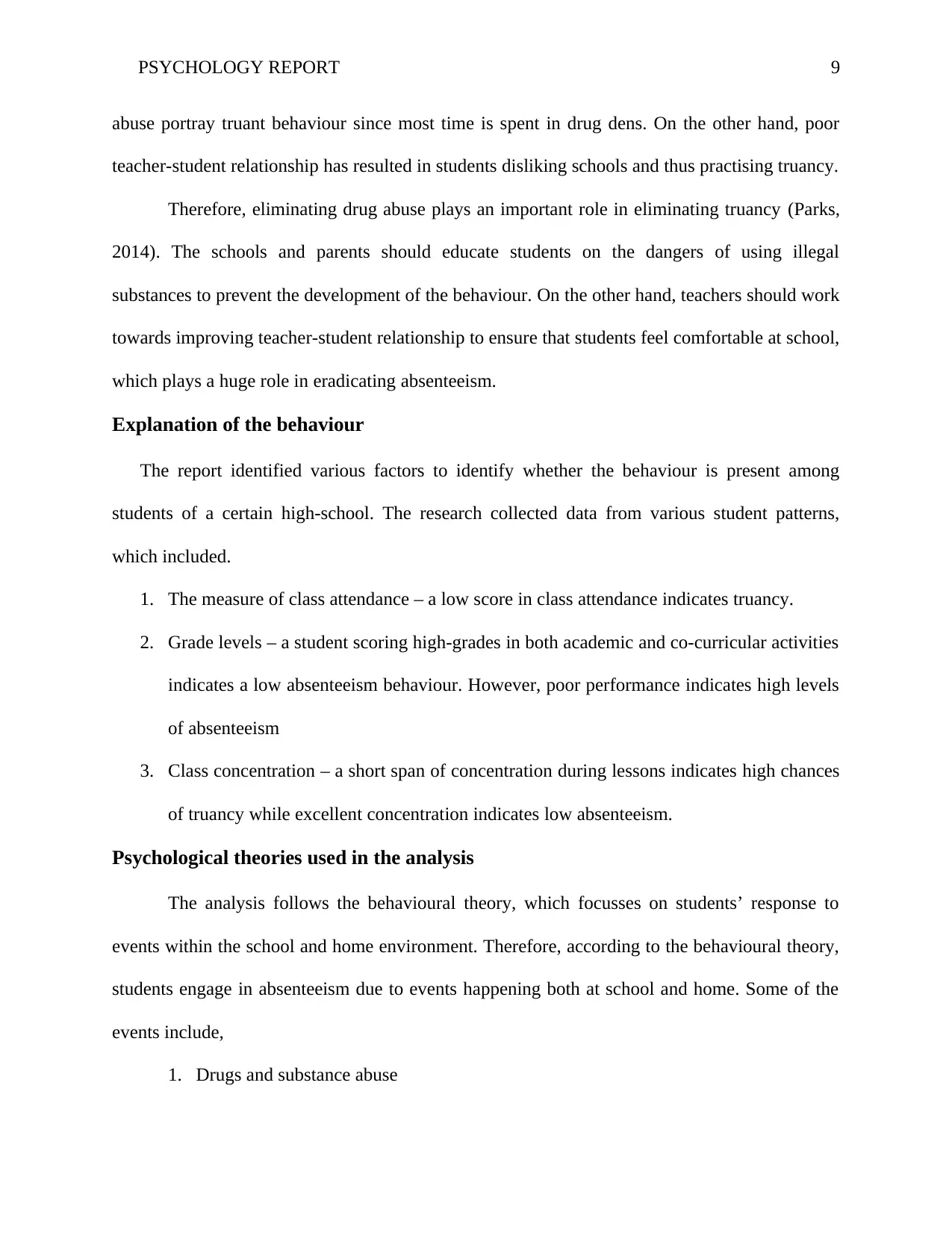
PSYCHOLOGY REPORT 9
abuse portray truant behaviour since most time is spent in drug dens. On the other hand, poor
teacher-student relationship has resulted in students disliking schools and thus practising truancy.
Therefore, eliminating drug abuse plays an important role in eliminating truancy (Parks,
2014). The schools and parents should educate students on the dangers of using illegal
substances to prevent the development of the behaviour. On the other hand, teachers should work
towards improving teacher-student relationship to ensure that students feel comfortable at school,
which plays a huge role in eradicating absenteeism.
Explanation of the behaviour
The report identified various factors to identify whether the behaviour is present among
students of a certain high-school. The research collected data from various student patterns,
which included.
1. The measure of class attendance – a low score in class attendance indicates truancy.
2. Grade levels – a student scoring high-grades in both academic and co-curricular activities
indicates a low absenteeism behaviour. However, poor performance indicates high levels
of absenteeism
3. Class concentration – a short span of concentration during lessons indicates high chances
of truancy while excellent concentration indicates low absenteeism.
Psychological theories used in the analysis
The analysis follows the behavioural theory, which focusses on students’ response to
events within the school and home environment. Therefore, according to the behavioural theory,
students engage in absenteeism due to events happening both at school and home. Some of the
events include,
1. Drugs and substance abuse
abuse portray truant behaviour since most time is spent in drug dens. On the other hand, poor
teacher-student relationship has resulted in students disliking schools and thus practising truancy.
Therefore, eliminating drug abuse plays an important role in eliminating truancy (Parks,
2014). The schools and parents should educate students on the dangers of using illegal
substances to prevent the development of the behaviour. On the other hand, teachers should work
towards improving teacher-student relationship to ensure that students feel comfortable at school,
which plays a huge role in eradicating absenteeism.
Explanation of the behaviour
The report identified various factors to identify whether the behaviour is present among
students of a certain high-school. The research collected data from various student patterns,
which included.
1. The measure of class attendance – a low score in class attendance indicates truancy.
2. Grade levels – a student scoring high-grades in both academic and co-curricular activities
indicates a low absenteeism behaviour. However, poor performance indicates high levels
of absenteeism
3. Class concentration – a short span of concentration during lessons indicates high chances
of truancy while excellent concentration indicates low absenteeism.
Psychological theories used in the analysis
The analysis follows the behavioural theory, which focusses on students’ response to
events within the school and home environment. Therefore, according to the behavioural theory,
students engage in absenteeism due to events happening both at school and home. Some of the
events include,
1. Drugs and substance abuse
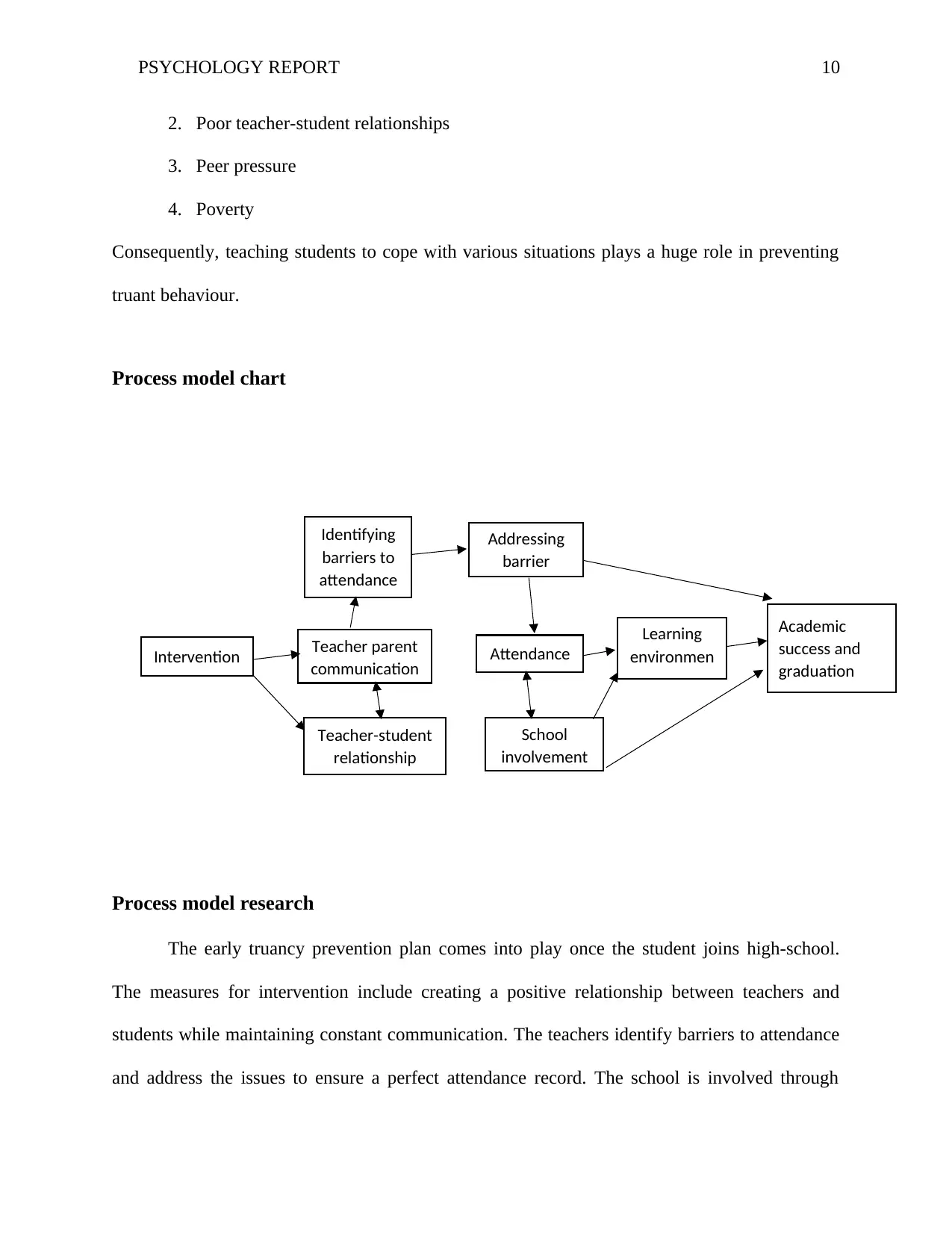
PSYCHOLOGY REPORT 10
2. Poor teacher-student relationships
3. Peer pressure
4. Poverty
Consequently, teaching students to cope with various situations plays a huge role in preventing
truant behaviour.
Process model chart
Process model research
The early truancy prevention plan comes into play once the student joins high-school.
The measures for intervention include creating a positive relationship between teachers and
students while maintaining constant communication. The teachers identify barriers to attendance
and address the issues to ensure a perfect attendance record. The school is involved through
Intervention
Identifying
barriers to
attendance
Teacher parent
communication Attendance
School
involvement
Academic
success and
graduation
Teacher-student
relationship
Addressing
barrier
Learning
environmen
t
2. Poor teacher-student relationships
3. Peer pressure
4. Poverty
Consequently, teaching students to cope with various situations plays a huge role in preventing
truant behaviour.
Process model chart
Process model research
The early truancy prevention plan comes into play once the student joins high-school.
The measures for intervention include creating a positive relationship between teachers and
students while maintaining constant communication. The teachers identify barriers to attendance
and address the issues to ensure a perfect attendance record. The school is involved through
Intervention
Identifying
barriers to
attendance
Teacher parent
communication Attendance
School
involvement
Academic
success and
graduation
Teacher-student
relationship
Addressing
barrier
Learning
environmen
t
Secure Best Marks with AI Grader
Need help grading? Try our AI Grader for instant feedback on your assignments.
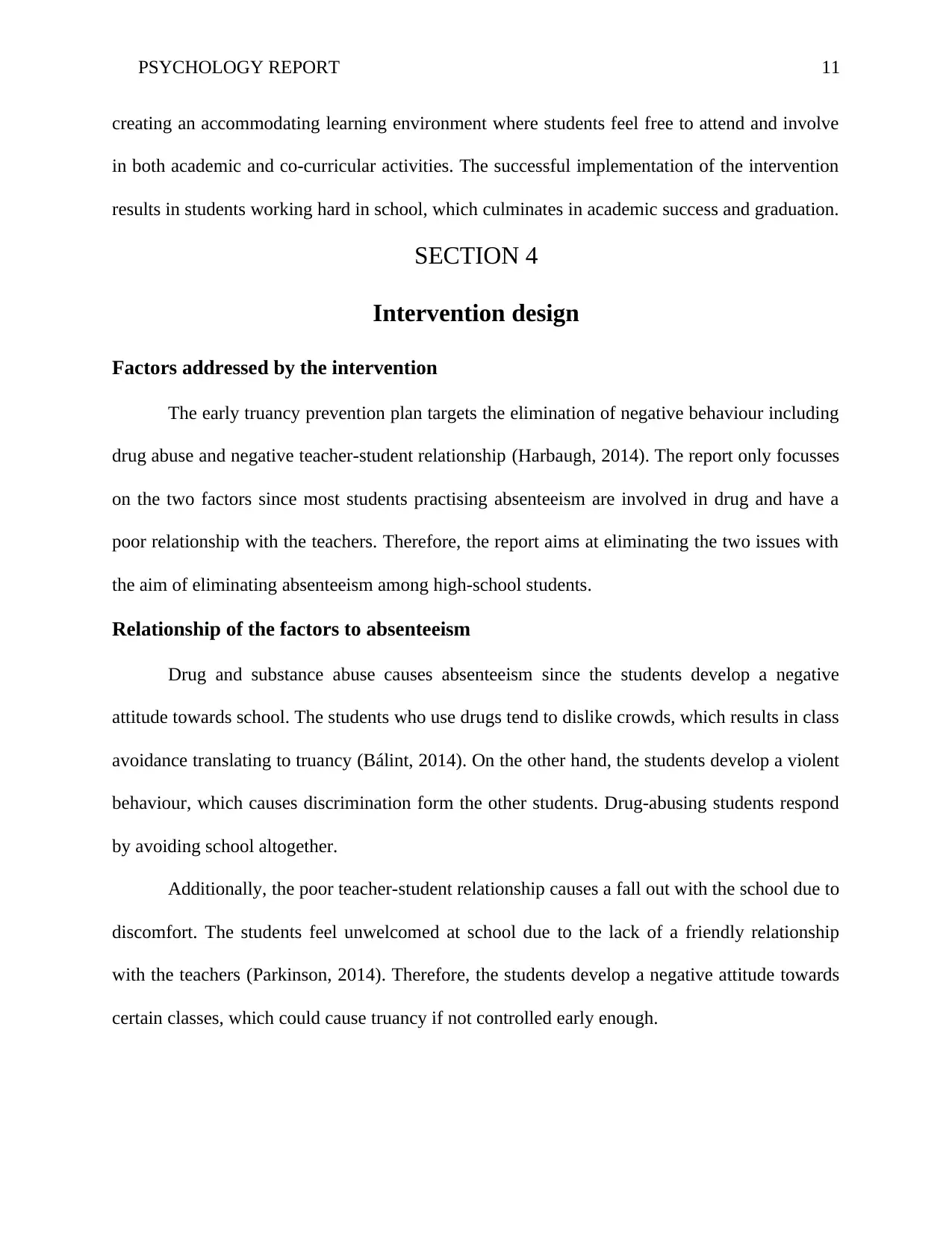
PSYCHOLOGY REPORT 11
creating an accommodating learning environment where students feel free to attend and involve
in both academic and co-curricular activities. The successful implementation of the intervention
results in students working hard in school, which culminates in academic success and graduation.
SECTION 4
Intervention design
Factors addressed by the intervention
The early truancy prevention plan targets the elimination of negative behaviour including
drug abuse and negative teacher-student relationship (Harbaugh, 2014). The report only focusses
on the two factors since most students practising absenteeism are involved in drug and have a
poor relationship with the teachers. Therefore, the report aims at eliminating the two issues with
the aim of eliminating absenteeism among high-school students.
Relationship of the factors to absenteeism
Drug and substance abuse causes absenteeism since the students develop a negative
attitude towards school. The students who use drugs tend to dislike crowds, which results in class
avoidance translating to truancy (Bálint, 2014). On the other hand, the students develop a violent
behaviour, which causes discrimination form the other students. Drug-abusing students respond
by avoiding school altogether.
Additionally, the poor teacher-student relationship causes a fall out with the school due to
discomfort. The students feel unwelcomed at school due to the lack of a friendly relationship
with the teachers (Parkinson, 2014). Therefore, the students develop a negative attitude towards
certain classes, which could cause truancy if not controlled early enough.
creating an accommodating learning environment where students feel free to attend and involve
in both academic and co-curricular activities. The successful implementation of the intervention
results in students working hard in school, which culminates in academic success and graduation.
SECTION 4
Intervention design
Factors addressed by the intervention
The early truancy prevention plan targets the elimination of negative behaviour including
drug abuse and negative teacher-student relationship (Harbaugh, 2014). The report only focusses
on the two factors since most students practising absenteeism are involved in drug and have a
poor relationship with the teachers. Therefore, the report aims at eliminating the two issues with
the aim of eliminating absenteeism among high-school students.
Relationship of the factors to absenteeism
Drug and substance abuse causes absenteeism since the students develop a negative
attitude towards school. The students who use drugs tend to dislike crowds, which results in class
avoidance translating to truancy (Bálint, 2014). On the other hand, the students develop a violent
behaviour, which causes discrimination form the other students. Drug-abusing students respond
by avoiding school altogether.
Additionally, the poor teacher-student relationship causes a fall out with the school due to
discomfort. The students feel unwelcomed at school due to the lack of a friendly relationship
with the teachers (Parkinson, 2014). Therefore, the students develop a negative attitude towards
certain classes, which could cause truancy if not controlled early enough.
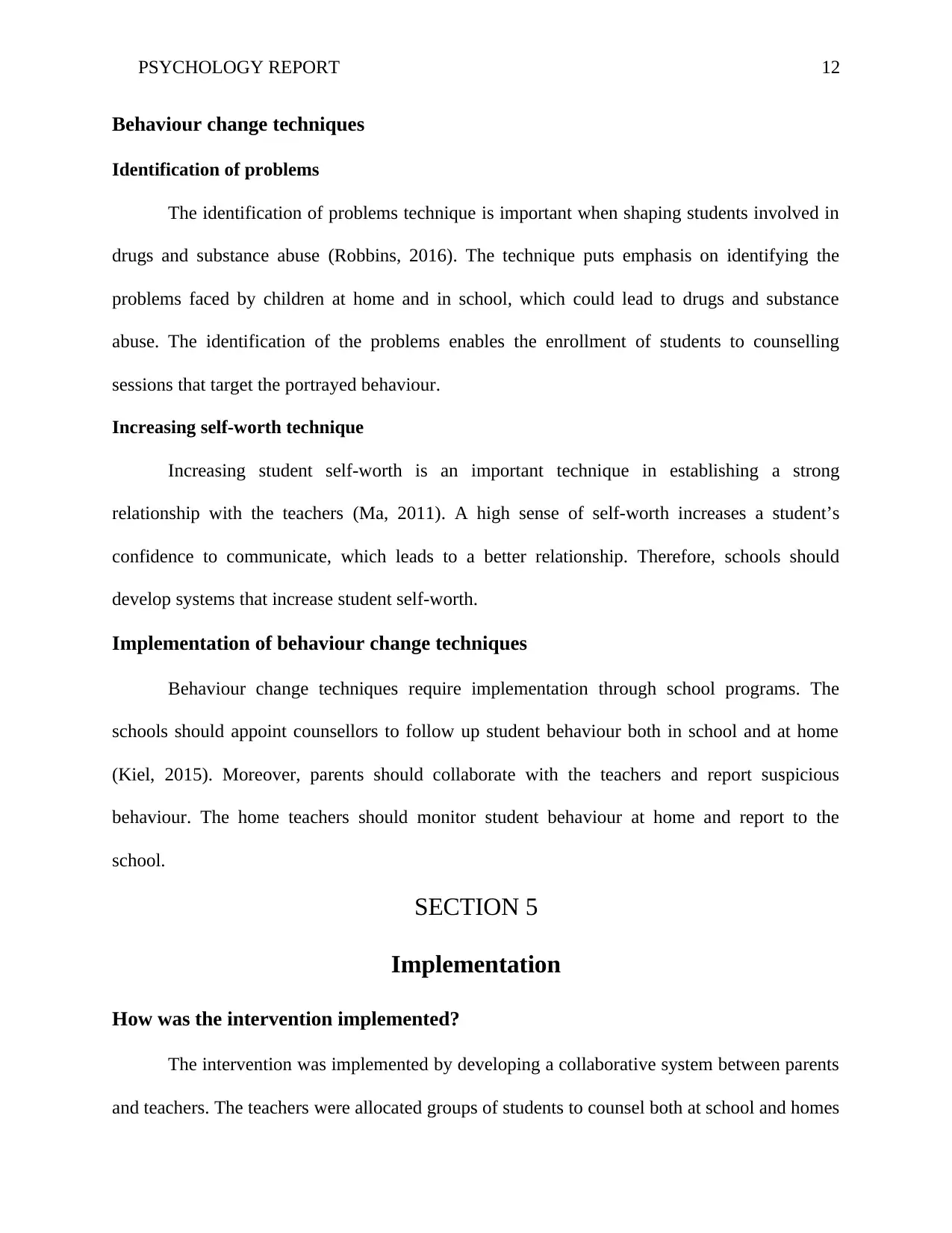
PSYCHOLOGY REPORT 12
Behaviour change techniques
Identification of problems
The identification of problems technique is important when shaping students involved in
drugs and substance abuse (Robbins, 2016). The technique puts emphasis on identifying the
problems faced by children at home and in school, which could lead to drugs and substance
abuse. The identification of the problems enables the enrollment of students to counselling
sessions that target the portrayed behaviour.
Increasing self-worth technique
Increasing student self-worth is an important technique in establishing a strong
relationship with the teachers (Ma, 2011). A high sense of self-worth increases a student’s
confidence to communicate, which leads to a better relationship. Therefore, schools should
develop systems that increase student self-worth.
Implementation of behaviour change techniques
Behaviour change techniques require implementation through school programs. The
schools should appoint counsellors to follow up student behaviour both in school and at home
(Kiel, 2015). Moreover, parents should collaborate with the teachers and report suspicious
behaviour. The home teachers should monitor student behaviour at home and report to the
school.
SECTION 5
Implementation
How was the intervention implemented?
The intervention was implemented by developing a collaborative system between parents
and teachers. The teachers were allocated groups of students to counsel both at school and homes
Behaviour change techniques
Identification of problems
The identification of problems technique is important when shaping students involved in
drugs and substance abuse (Robbins, 2016). The technique puts emphasis on identifying the
problems faced by children at home and in school, which could lead to drugs and substance
abuse. The identification of the problems enables the enrollment of students to counselling
sessions that target the portrayed behaviour.
Increasing self-worth technique
Increasing student self-worth is an important technique in establishing a strong
relationship with the teachers (Ma, 2011). A high sense of self-worth increases a student’s
confidence to communicate, which leads to a better relationship. Therefore, schools should
develop systems that increase student self-worth.
Implementation of behaviour change techniques
Behaviour change techniques require implementation through school programs. The
schools should appoint counsellors to follow up student behaviour both in school and at home
(Kiel, 2015). Moreover, parents should collaborate with the teachers and report suspicious
behaviour. The home teachers should monitor student behaviour at home and report to the
school.
SECTION 5
Implementation
How was the intervention implemented?
The intervention was implemented by developing a collaborative system between parents
and teachers. The teachers were allocated groups of students to counsel both at school and homes
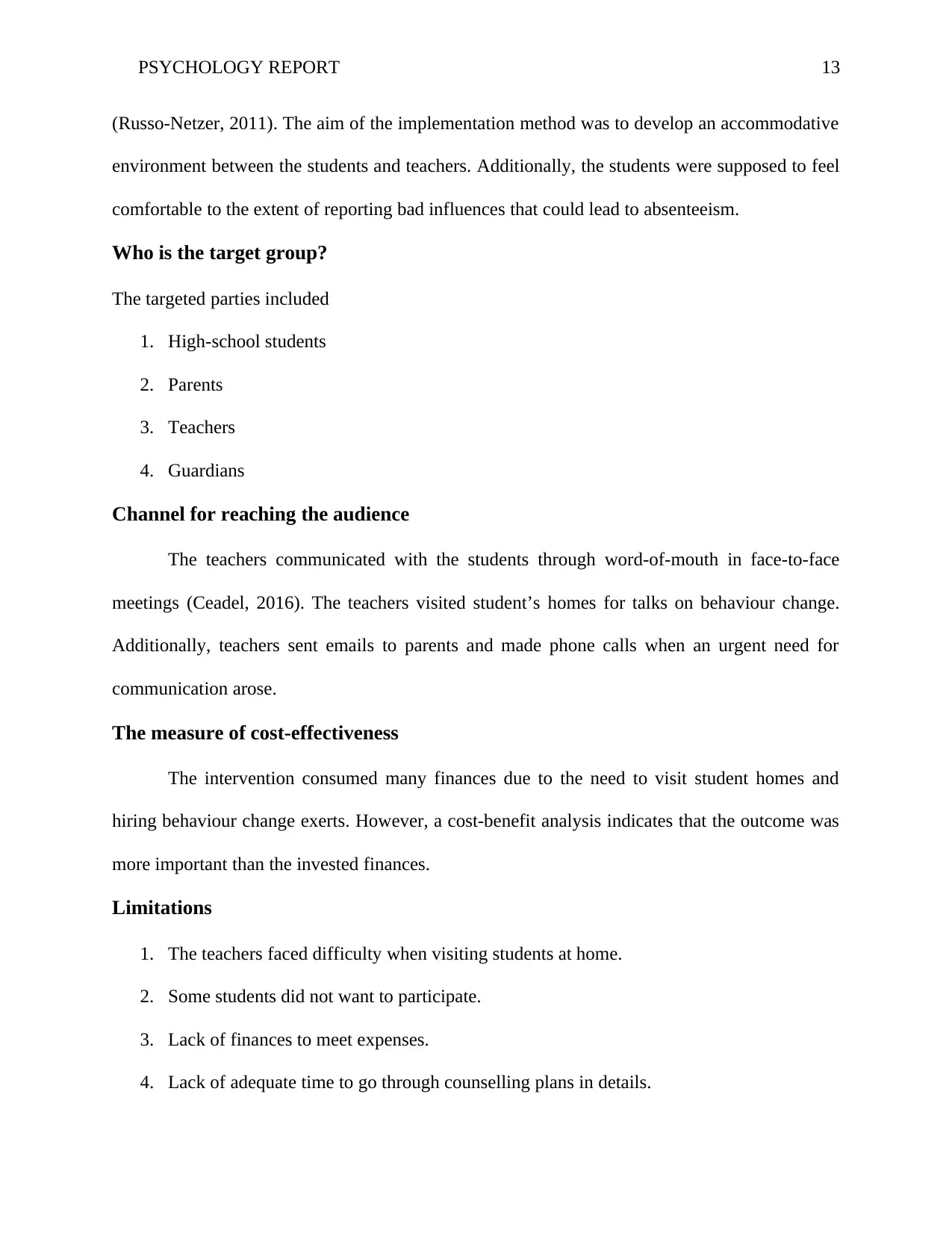
PSYCHOLOGY REPORT 13
(Russo-Netzer, 2011). The aim of the implementation method was to develop an accommodative
environment between the students and teachers. Additionally, the students were supposed to feel
comfortable to the extent of reporting bad influences that could lead to absenteeism.
Who is the target group?
The targeted parties included
1. High-school students
2. Parents
3. Teachers
4. Guardians
Channel for reaching the audience
The teachers communicated with the students through word-of-mouth in face-to-face
meetings (Ceadel, 2016). The teachers visited student’s homes for talks on behaviour change.
Additionally, teachers sent emails to parents and made phone calls when an urgent need for
communication arose.
The measure of cost-effectiveness
The intervention consumed many finances due to the need to visit student homes and
hiring behaviour change exerts. However, a cost-benefit analysis indicates that the outcome was
more important than the invested finances.
Limitations
1. The teachers faced difficulty when visiting students at home.
2. Some students did not want to participate.
3. Lack of finances to meet expenses.
4. Lack of adequate time to go through counselling plans in details.
(Russo-Netzer, 2011). The aim of the implementation method was to develop an accommodative
environment between the students and teachers. Additionally, the students were supposed to feel
comfortable to the extent of reporting bad influences that could lead to absenteeism.
Who is the target group?
The targeted parties included
1. High-school students
2. Parents
3. Teachers
4. Guardians
Channel for reaching the audience
The teachers communicated with the students through word-of-mouth in face-to-face
meetings (Ceadel, 2016). The teachers visited student’s homes for talks on behaviour change.
Additionally, teachers sent emails to parents and made phone calls when an urgent need for
communication arose.
The measure of cost-effectiveness
The intervention consumed many finances due to the need to visit student homes and
hiring behaviour change exerts. However, a cost-benefit analysis indicates that the outcome was
more important than the invested finances.
Limitations
1. The teachers faced difficulty when visiting students at home.
2. Some students did not want to participate.
3. Lack of finances to meet expenses.
4. Lack of adequate time to go through counselling plans in details.
Paraphrase This Document
Need a fresh take? Get an instant paraphrase of this document with our AI Paraphraser
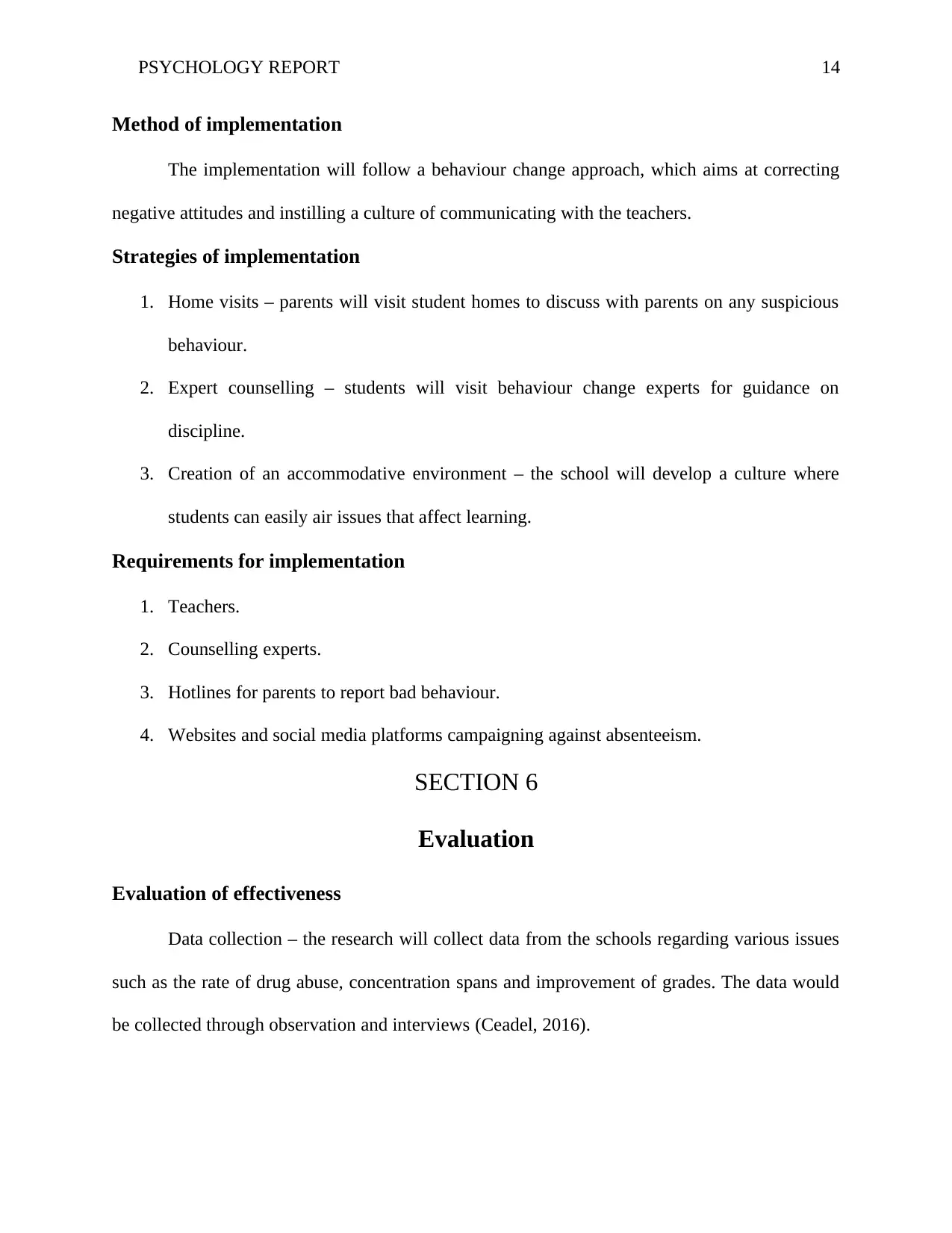
PSYCHOLOGY REPORT 14
Method of implementation
The implementation will follow a behaviour change approach, which aims at correcting
negative attitudes and instilling a culture of communicating with the teachers.
Strategies of implementation
1. Home visits – parents will visit student homes to discuss with parents on any suspicious
behaviour.
2. Expert counselling – students will visit behaviour change experts for guidance on
discipline.
3. Creation of an accommodative environment – the school will develop a culture where
students can easily air issues that affect learning.
Requirements for implementation
1. Teachers.
2. Counselling experts.
3. Hotlines for parents to report bad behaviour.
4. Websites and social media platforms campaigning against absenteeism.
SECTION 6
Evaluation
Evaluation of effectiveness
Data collection – the research will collect data from the schools regarding various issues
such as the rate of drug abuse, concentration spans and improvement of grades. The data would
be collected through observation and interviews (Ceadel, 2016).
Method of implementation
The implementation will follow a behaviour change approach, which aims at correcting
negative attitudes and instilling a culture of communicating with the teachers.
Strategies of implementation
1. Home visits – parents will visit student homes to discuss with parents on any suspicious
behaviour.
2. Expert counselling – students will visit behaviour change experts for guidance on
discipline.
3. Creation of an accommodative environment – the school will develop a culture where
students can easily air issues that affect learning.
Requirements for implementation
1. Teachers.
2. Counselling experts.
3. Hotlines for parents to report bad behaviour.
4. Websites and social media platforms campaigning against absenteeism.
SECTION 6
Evaluation
Evaluation of effectiveness
Data collection – the research will collect data from the schools regarding various issues
such as the rate of drug abuse, concentration spans and improvement of grades. The data would
be collected through observation and interviews (Ceadel, 2016).
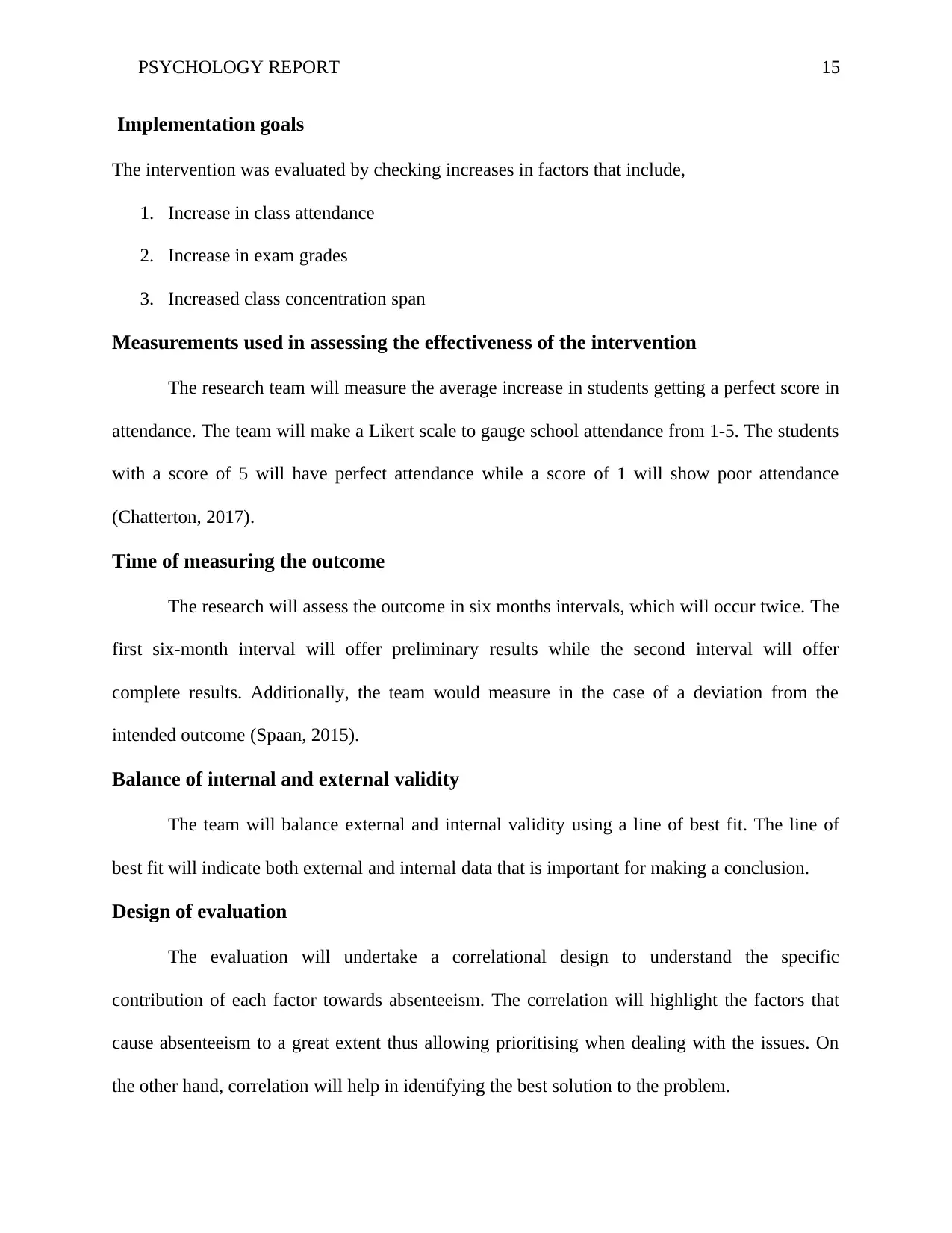
PSYCHOLOGY REPORT 15
Implementation goals
The intervention was evaluated by checking increases in factors that include,
1. Increase in class attendance
2. Increase in exam grades
3. Increased class concentration span
Measurements used in assessing the effectiveness of the intervention
The research team will measure the average increase in students getting a perfect score in
attendance. The team will make a Likert scale to gauge school attendance from 1-5. The students
with a score of 5 will have perfect attendance while a score of 1 will show poor attendance
(Chatterton, 2017).
Time of measuring the outcome
The research will assess the outcome in six months intervals, which will occur twice. The
first six-month interval will offer preliminary results while the second interval will offer
complete results. Additionally, the team would measure in the case of a deviation from the
intended outcome (Spaan, 2015).
Balance of internal and external validity
The team will balance external and internal validity using a line of best fit. The line of
best fit will indicate both external and internal data that is important for making a conclusion.
Design of evaluation
The evaluation will undertake a correlational design to understand the specific
contribution of each factor towards absenteeism. The correlation will highlight the factors that
cause absenteeism to a great extent thus allowing prioritising when dealing with the issues. On
the other hand, correlation will help in identifying the best solution to the problem.
Implementation goals
The intervention was evaluated by checking increases in factors that include,
1. Increase in class attendance
2. Increase in exam grades
3. Increased class concentration span
Measurements used in assessing the effectiveness of the intervention
The research team will measure the average increase in students getting a perfect score in
attendance. The team will make a Likert scale to gauge school attendance from 1-5. The students
with a score of 5 will have perfect attendance while a score of 1 will show poor attendance
(Chatterton, 2017).
Time of measuring the outcome
The research will assess the outcome in six months intervals, which will occur twice. The
first six-month interval will offer preliminary results while the second interval will offer
complete results. Additionally, the team would measure in the case of a deviation from the
intended outcome (Spaan, 2015).
Balance of internal and external validity
The team will balance external and internal validity using a line of best fit. The line of
best fit will indicate both external and internal data that is important for making a conclusion.
Design of evaluation
The evaluation will undertake a correlational design to understand the specific
contribution of each factor towards absenteeism. The correlation will highlight the factors that
cause absenteeism to a great extent thus allowing prioritising when dealing with the issues. On
the other hand, correlation will help in identifying the best solution to the problem.
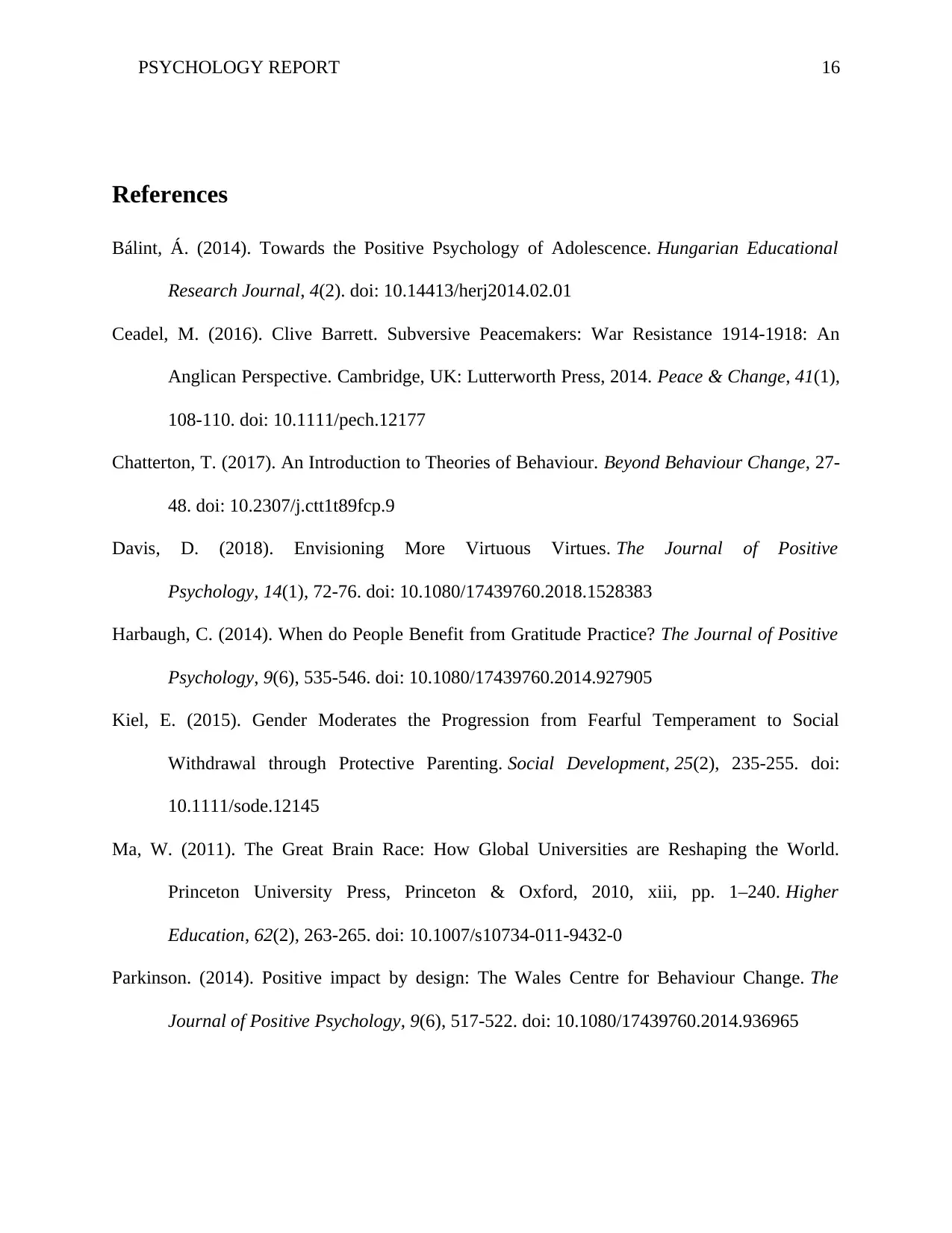
PSYCHOLOGY REPORT 16
References
Bálint, Á. (2014). Towards the Positive Psychology of Adolescence. Hungarian Educational
Research Journal, 4(2). doi: 10.14413/herj2014.02.01
Ceadel, M. (2016). Clive Barrett. Subversive Peacemakers: War Resistance 1914-1918: An
Anglican Perspective. Cambridge, UK: Lutterworth Press, 2014. Peace & Change, 41(1),
108-110. doi: 10.1111/pech.12177
Chatterton, T. (2017). An Introduction to Theories of Behaviour. Beyond Behaviour Change, 27-
48. doi: 10.2307/j.ctt1t89fcp.9
Davis, D. (2018). Envisioning More Virtuous Virtues. The Journal of Positive
Psychology, 14(1), 72-76. doi: 10.1080/17439760.2018.1528383
Harbaugh, C. (2014). When do People Benefit from Gratitude Practice? The Journal of Positive
Psychology, 9(6), 535-546. doi: 10.1080/17439760.2014.927905
Kiel, E. (2015). Gender Moderates the Progression from Fearful Temperament to Social
Withdrawal through Protective Parenting. Social Development, 25(2), 235-255. doi:
10.1111/sode.12145
Ma, W. (2011). The Great Brain Race: How Global Universities are Reshaping the World.
Princeton University Press, Princeton & Oxford, 2010, xiii, pp. 1–240. Higher
Education, 62(2), 263-265. doi: 10.1007/s10734-011-9432-0
Parkinson. (2014). Positive impact by design: The Wales Centre for Behaviour Change. The
Journal of Positive Psychology, 9(6), 517-522. doi: 10.1080/17439760.2014.936965
References
Bálint, Á. (2014). Towards the Positive Psychology of Adolescence. Hungarian Educational
Research Journal, 4(2). doi: 10.14413/herj2014.02.01
Ceadel, M. (2016). Clive Barrett. Subversive Peacemakers: War Resistance 1914-1918: An
Anglican Perspective. Cambridge, UK: Lutterworth Press, 2014. Peace & Change, 41(1),
108-110. doi: 10.1111/pech.12177
Chatterton, T. (2017). An Introduction to Theories of Behaviour. Beyond Behaviour Change, 27-
48. doi: 10.2307/j.ctt1t89fcp.9
Davis, D. (2018). Envisioning More Virtuous Virtues. The Journal of Positive
Psychology, 14(1), 72-76. doi: 10.1080/17439760.2018.1528383
Harbaugh, C. (2014). When do People Benefit from Gratitude Practice? The Journal of Positive
Psychology, 9(6), 535-546. doi: 10.1080/17439760.2014.927905
Kiel, E. (2015). Gender Moderates the Progression from Fearful Temperament to Social
Withdrawal through Protective Parenting. Social Development, 25(2), 235-255. doi:
10.1111/sode.12145
Ma, W. (2011). The Great Brain Race: How Global Universities are Reshaping the World.
Princeton University Press, Princeton & Oxford, 2010, xiii, pp. 1–240. Higher
Education, 62(2), 263-265. doi: 10.1007/s10734-011-9432-0
Parkinson. (2014). Positive impact by design: The Wales Centre for Behaviour Change. The
Journal of Positive Psychology, 9(6), 517-522. doi: 10.1080/17439760.2014.936965
Secure Best Marks with AI Grader
Need help grading? Try our AI Grader for instant feedback on your assignments.
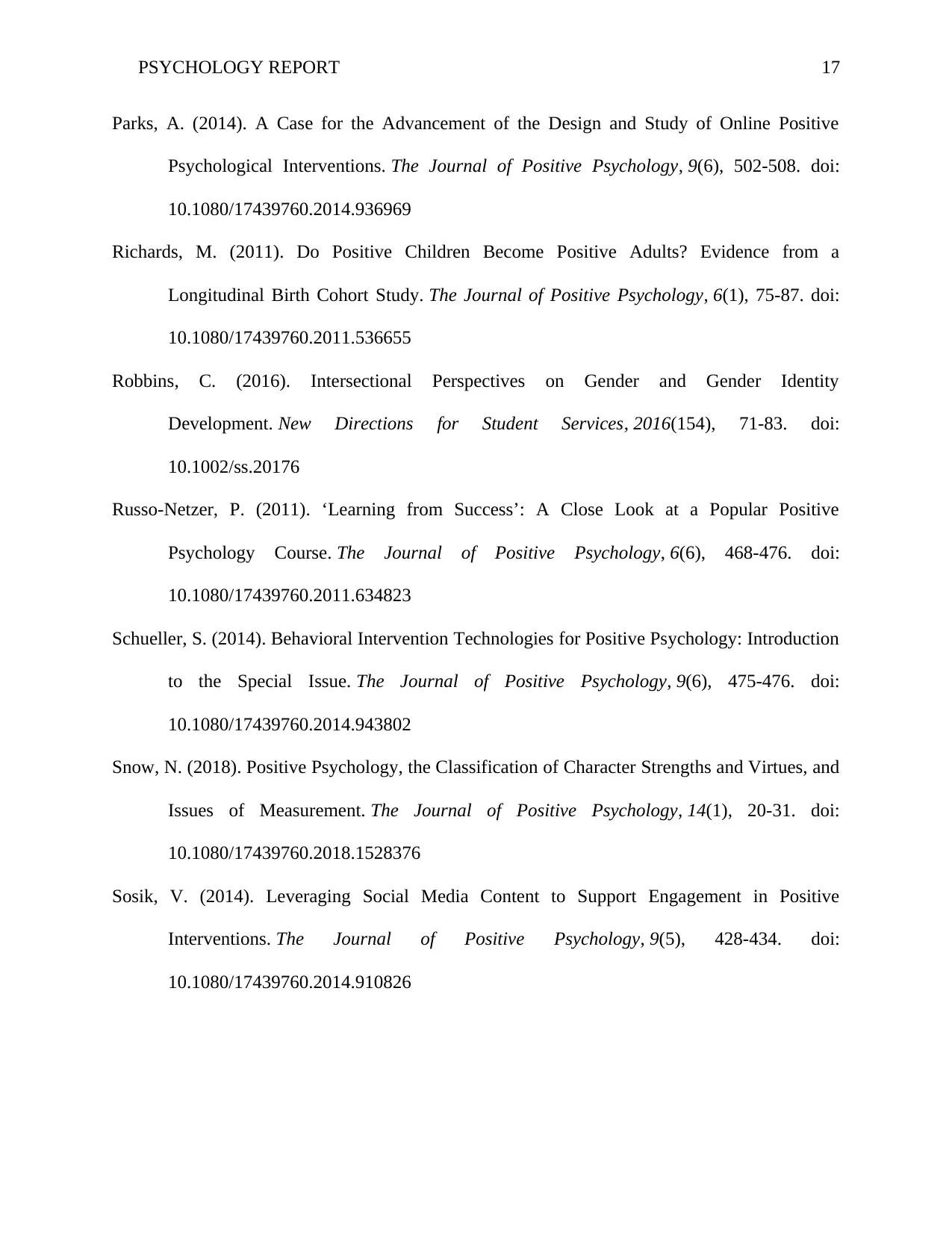
PSYCHOLOGY REPORT 17
Parks, A. (2014). A Case for the Advancement of the Design and Study of Online Positive
Psychological Interventions. The Journal of Positive Psychology, 9(6), 502-508. doi:
10.1080/17439760.2014.936969
Richards, M. (2011). Do Positive Children Become Positive Adults? Evidence from a
Longitudinal Birth Cohort Study. The Journal of Positive Psychology, 6(1), 75-87. doi:
10.1080/17439760.2011.536655
Robbins, C. (2016). Intersectional Perspectives on Gender and Gender Identity
Development. New Directions for Student Services, 2016(154), 71-83. doi:
10.1002/ss.20176
Russo-Netzer, P. (2011). ‘Learning from Success’: A Close Look at a Popular Positive
Psychology Course. The Journal of Positive Psychology, 6(6), 468-476. doi:
10.1080/17439760.2011.634823
Schueller, S. (2014). Behavioral Intervention Technologies for Positive Psychology: Introduction
to the Special Issue. The Journal of Positive Psychology, 9(6), 475-476. doi:
10.1080/17439760.2014.943802
Snow, N. (2018). Positive Psychology, the Classification of Character Strengths and Virtues, and
Issues of Measurement. The Journal of Positive Psychology, 14(1), 20-31. doi:
10.1080/17439760.2018.1528376
Sosik, V. (2014). Leveraging Social Media Content to Support Engagement in Positive
Interventions. The Journal of Positive Psychology, 9(5), 428-434. doi:
10.1080/17439760.2014.910826
Parks, A. (2014). A Case for the Advancement of the Design and Study of Online Positive
Psychological Interventions. The Journal of Positive Psychology, 9(6), 502-508. doi:
10.1080/17439760.2014.936969
Richards, M. (2011). Do Positive Children Become Positive Adults? Evidence from a
Longitudinal Birth Cohort Study. The Journal of Positive Psychology, 6(1), 75-87. doi:
10.1080/17439760.2011.536655
Robbins, C. (2016). Intersectional Perspectives on Gender and Gender Identity
Development. New Directions for Student Services, 2016(154), 71-83. doi:
10.1002/ss.20176
Russo-Netzer, P. (2011). ‘Learning from Success’: A Close Look at a Popular Positive
Psychology Course. The Journal of Positive Psychology, 6(6), 468-476. doi:
10.1080/17439760.2011.634823
Schueller, S. (2014). Behavioral Intervention Technologies for Positive Psychology: Introduction
to the Special Issue. The Journal of Positive Psychology, 9(6), 475-476. doi:
10.1080/17439760.2014.943802
Snow, N. (2018). Positive Psychology, the Classification of Character Strengths and Virtues, and
Issues of Measurement. The Journal of Positive Psychology, 14(1), 20-31. doi:
10.1080/17439760.2018.1528376
Sosik, V. (2014). Leveraging Social Media Content to Support Engagement in Positive
Interventions. The Journal of Positive Psychology, 9(5), 428-434. doi:
10.1080/17439760.2014.910826
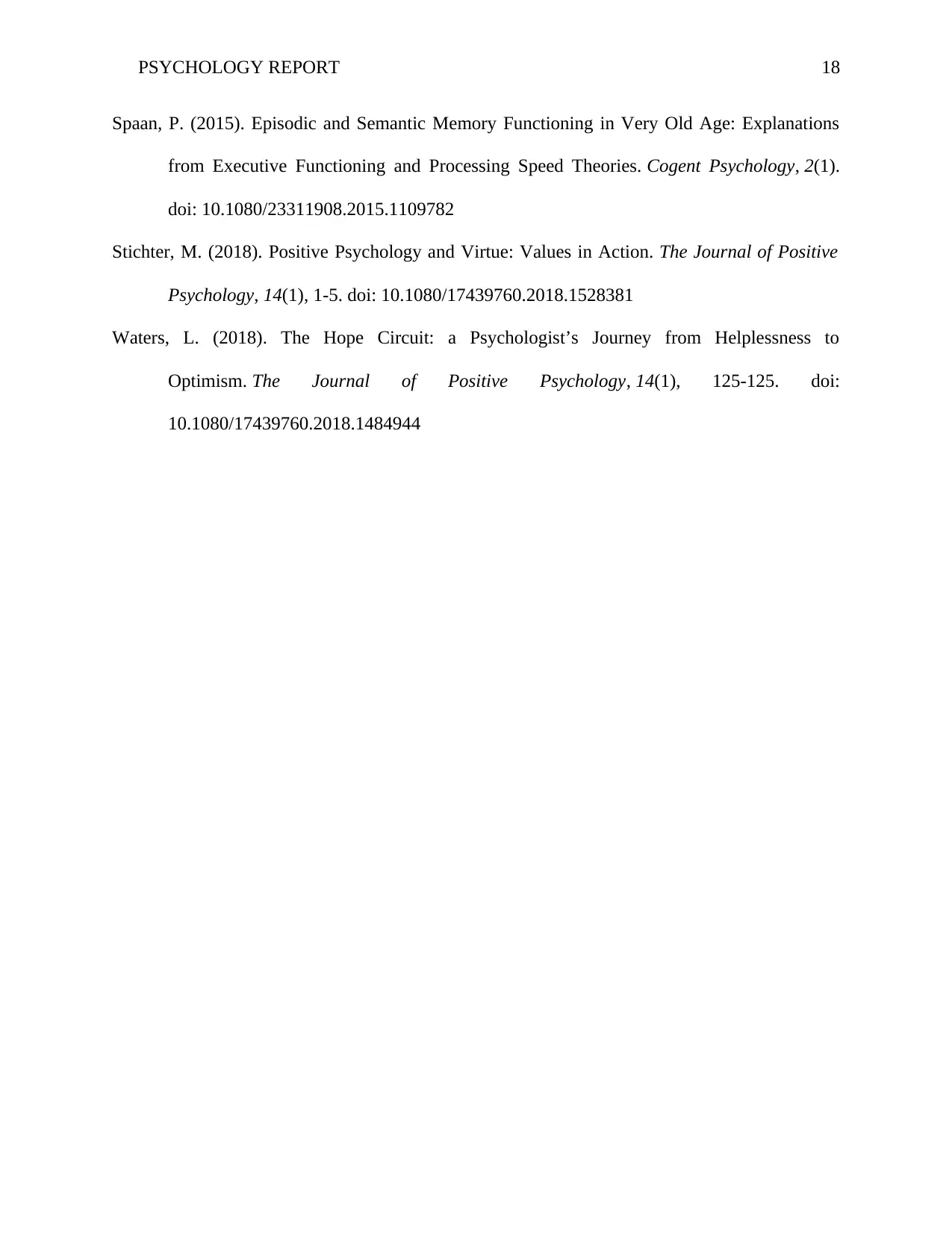
PSYCHOLOGY REPORT 18
Spaan, P. (2015). Episodic and Semantic Memory Functioning in Very Old Age: Explanations
from Executive Functioning and Processing Speed Theories. Cogent Psychology, 2(1).
doi: 10.1080/23311908.2015.1109782
Stichter, M. (2018). Positive Psychology and Virtue: Values in Action. The Journal of Positive
Psychology, 14(1), 1-5. doi: 10.1080/17439760.2018.1528381
Waters, L. (2018). The Hope Circuit: a Psychologist’s Journey from Helplessness to
Optimism. The Journal of Positive Psychology, 14(1), 125-125. doi:
10.1080/17439760.2018.1484944
Spaan, P. (2015). Episodic and Semantic Memory Functioning in Very Old Age: Explanations
from Executive Functioning and Processing Speed Theories. Cogent Psychology, 2(1).
doi: 10.1080/23311908.2015.1109782
Stichter, M. (2018). Positive Psychology and Virtue: Values in Action. The Journal of Positive
Psychology, 14(1), 1-5. doi: 10.1080/17439760.2018.1528381
Waters, L. (2018). The Hope Circuit: a Psychologist’s Journey from Helplessness to
Optimism. The Journal of Positive Psychology, 14(1), 125-125. doi:
10.1080/17439760.2018.1484944
1 out of 18
Related Documents
Your All-in-One AI-Powered Toolkit for Academic Success.
+13062052269
info@desklib.com
Available 24*7 on WhatsApp / Email
![[object Object]](/_next/static/media/star-bottom.7253800d.svg)
Unlock your academic potential
© 2024 | Zucol Services PVT LTD | All rights reserved.





